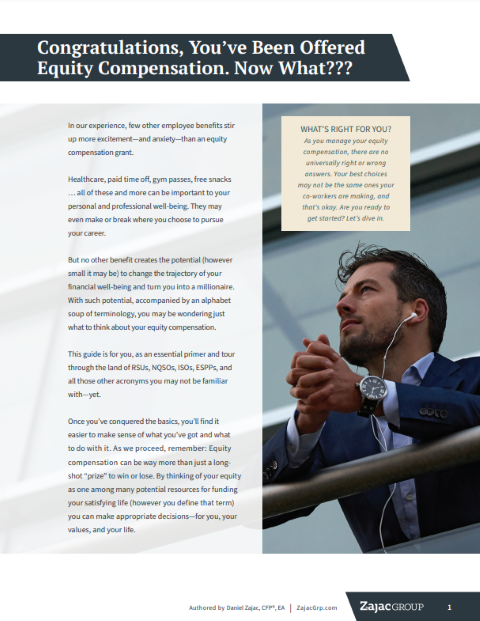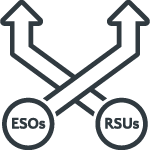An employee stock purchase plan is a compensation tool that may allow you to purchase shares of company stock through convenient payroll deductions.
Employee stock purchase plans, or ESPPs, allow you to buy company stock at a discount or a favorable price. Through the plan, you could also receive preferential tax treatment on the profits if you meet specific holding period requirements for the shares you buy.
If your employer offers an ESPP but you’re unsure if you should participate, here’s what to know to help you decide whether or not you’d like to take advantage.
1 – You Buy Shares of Company Stock Through an ESPP
An employee stock purchase plan allows you to buy shares of company stock. Owning shares of company stock may be good if you think the stock price will go up, but it comes with several risks.
The most apparent risk is one all investments carry: there’s a risk of loss, as there’s no guarantee your investment will increase in value. You could buy shares, hold them, and see their price fall below what you paid.
A second risk to be aware of is concentration risk. Before you participate in your ESPP, and especially if you plan to participate and hold the stock (instead of immediately selling the shares to lock in any discount you may receive), you need to know what it means to hold a single stock position.
GET THIS GUIDE
When it comes to your finances, it's important to understand what you have, what you should consider, and how it can impact your personal goals. This guide is the best place to start.
You should also consider that you hold company stock and your employer pays your salary, so if something happens to the business, both your investments and your cash flow could be negatively impacted.
2 – You Usually Fund an Employee Stock Purchase Plan with Payroll Deductions
Most employee stock purchase plans are set up so that enrolling into one allows you to elect to defer a set percentage or amount of your paycheck to the plan.
This makes contributions easy and convenient, which many employees see as an attractive feature of ESPPs. However, a qualified ESPP has a maximum annual contribution of $25,000.
Once you enroll, your employer automatically deducts a portion of your paycheck into the ESPP, much like 401(k) contributions are deducted from your pay. However, unlike a traditional 401(k) plan, in which you fund the plan with pre-tax deferrals, ESPP contributions are made with after-tax money.
Contributions from payroll can likely be turned on and off at set intervals per the rules of your plan document.
3 – Purchases in an Employee Stock Purchase Plan Are Made at Set Intervals
Many plans provide an “offering period.” During this window, your employer collects your payroll contributions.
Your plan will also have a purchase date. On this date, your employer will use the funds collected during the offering period to buy stock.
For example, your plan may have an offering period of 2 years and a purchase date of every 6 months. You may be eligible to participate in the plan for 2 years. During those 2 years, there will be 4 times during which shares will be purchased:
- At 6 months
- At 12 months
- At 18 months
- At 24 months
From months 0 to 6, your contributions go into a trust until the purchase date at the 6-month mark. At that time, your employer uses the funds to purchase shares for you.
Contributions accumulate in the trust again for another 6 months, until the 12-month purchase date when your employer buys shares. This process will continue until the end of your 2-year offering period.
4 – You May Have a Beneficial “Lookback” Provision
The price you pay for the shares purchased through your ESPP will depend on several factors.
For some plans, the price you pay will be the stock’s fair market value on the purchase date. For others, you should check if your plan allows for a lookback provision.
A lookback provision allows an ESPP to purchase shares of stock at the purchase date price or the grant date price, whichever is lower. The grant date price is typically the price of the stock when the offering period begins.
For example, say the grant date price for your employee stock purchase plan shares was $100 per share, and the purchase date price was $150 per share. Over the last 6 months, if you’re set to max out how much you can contribute, you would have put $12,500 into your plan.
If you have a lookback provision, here’s how your ESPP could purchase these shares on your behalf at the offering date price:
Payroll Deductions Collected / Offering Date Price = Shares Purchased
$12,500 / $100 = 125 shares
Shares Purchased x Purchase Date Price = Current Value
125 x $150 = $18,750
In this scenario, you will have contributed and paid $12,500 for something immediately worth $18,750. You will have benefited from “free” stock price appreciation during the 6 months.
If the stock price went down—let’s say it dropped from $100 to $50 per share—you would be able to buy the same 125 shares at the $50 per share purchase date price.
5 – Your Employee Stock Purchase Plan May Allow You to Buy at a Discount
Many employee stock purchase plans will offer a discount of up to 15% on the purchase of company stock. Buying something at a 15% discount that you can immediately sell for full market value means locking in a profit of at least 15%.
Remember to check your plan document to confirm whether you receive such a discount. Not all plans are the same, and some don’t offer the ability to buy at a discount (or the percentage of that discount might be something other than 15%).
A 15% discount can be even more beneficial if you can combine it with the lookback provision. In our example above, let’s assume that the stock price has gone up, and you paid $100 per share for shares currently valued at $150.
If your plan offers a $15 discount, you will pay $100 per share, less 15%, or $85 per share. In the example when the price drops during the offering period, you will pay $50 per share less 15%, or $42.50 per share.
6 – You May Pay Several Types of Tax When You Sell Your Shares
The purchase of stock via an ESPP is not a taxable event. Selling the shares is, however, a reportable event for tax purposes.
The type of tax you pay will depend on how long you hold the ESPP shares. More specifically, the sale of your ESPP shares will be identified as a qualifying or disqualifying disposition.
A qualifying sale meets the following criteria:
- The final sale occurs at least 2 years after the offer date
- The final sale occurs at least 1 year after the purchase date
Anything that does not meet these criteria is a disqualifying disposition.
The tax rules for an ESPP can be complicated. You’ll likely find yourself reporting a combination of compensation income and short- or long-term capital gains income, depending on the offering period price, purchase date price, and how long you held the shares since the purchase date.
Generally speaking, if you have a qualifying disposition, the discount received from the offering date price will likely be taxed as compensation income and at your regular tax rates.
However, your compensation income may be lower if you have a total realized gain when you sell less than the discount received. Gains, if any, over the offering date price will likely be taxed as a long-term capital gain.
If you have a disqualifying disposition, you’ll likely report compensation income on the discount received from the actual purchase price and short- or long-term capital gain/loss on anything in excess.
7 – Everything You Need to Know Lives in Your Employee Stock Purchase Plan Document
You’ve seen it here a few times, but I encourage you to obtain a copy of your plan document. This document will tell you the specifics of your plan.
By consulting the plan document, you can find out if you get to buy shares at a discount or not, and if your plan offers additional benefits like a lookback provision. The plan document will also detail when and how to enroll and when and how you can sell your shares.
If you still aren’t sure of the answers to your questions after reading it, it may be wise to talk with a professional who can help you navigate this potentially complex topic.
Your Employee Stock Purchase Plan May Be a Great Deal
As you can see, an employee stock purchase plan has many moving parts. It can get complex, but if you have access to this kind of company benefit, you may want to take advantage of it.
However, you’ll want to be sure this strategy fits into your overall financial plan and investment allocation. It should also fit within your cash flow because the money to fund the ESPP comes directly from your paycheck.
If you can buy shares at a discount, benefit from a lookback period, and sell the shares immediately after purchase — while also managing the change in cash flow as some money from your paycheck will go straight into the plan — an ESPP may allow for you to capture immediate profit with little to no risk.











Can you purchase during maternity leave? Is this something that I would have to check my plan for?